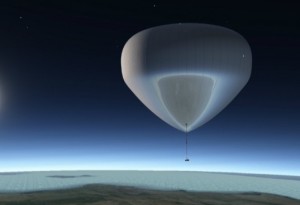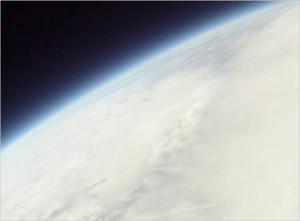Facts About Big Space Balloon
How will this giant balloon perform experiments at the edge of space?
The Big Space Balloon will be Britain’s largest high-altitude research balloon, taking experiments up to the edge of the cosmos and exploring the upper echelons of our atmosphere. It is set to launch mid- to late-2014, carrying a capsule full of scientific experiments to study the Earth and its atmosphere, before returning to our planet and possibly being re-launched in the future.
The balloon will be almost 75 metres (245 feet) tall and, once it has expanded in the thin atmosphere, it will reach a diameter of 100 metres (330 feet) and a volume of 400,000 cubic metres (14 million cubic feet). It has been designed to provide a low-cost alternative to taking a payload into orbit compared to an expensive rocket launch.
The entire Big Space balloon and capsule system will be roughly twice the height of Nelson’s Column and almost as wide as the height of the most powerful rocket of all time, the Saturn V. The design is a superpressure balloon envelope, which is designed to survive several days at the border of space. The balloon material will be made from 100 per cent recycled polythene.
 Attached to the balloon by a cable will be a capsule 2.9 metres (9.5 feet) tall and two metres (6.5 feet) wide. This will be made from the latest composite materials for strength and durability.
Attached to the balloon by a cable will be a capsule 2.9 metres (9.5 feet) tall and two metres (6.5 feet) wide. This will be made from the latest composite materials for strength and durability.
Filled with scientific instruments, the capsule will study the Earth and its atmosphere from a height of 40,000 metres (130,000 feet). At the end of its mission the capsule will parachute safely back to Earth, where it will be recovered and potentially used again in other similar missions.
Mission step by step
 1. Launch – On the ground, a crane will hold the capsule stationary as the balloon is filled with a mix of hydrogen and helium gas.
1. Launch – On the ground, a crane will hold the capsule stationary as the balloon is filled with a mix of hydrogen and helium gas.
2. Ascent – As atmospheric pressure drops the balloon starts to swell, because the gas inside is able to expand more easily and pushes out the thin polythene material.
3. Stratosphere – On the envelope is a series of photovoltaic cells, which convert solar energy into electricity as the balloon rises.
4. Target – After two hours the balloon will have reached its target altitude of 40km and a maximum volume of 400,000m3.
5. Descent – To begin the journey home, an explosive panel detonates a hole in the envelope so the balloon’s return to Earth can be controlled.
6. Parachute – At about 3km (1.9mi) the landing parachute is released, returning the capsule safely to the surface so it can be recovered.
7. Landing – The deflated balloon lands separately and is also recovered after completing its mission.
